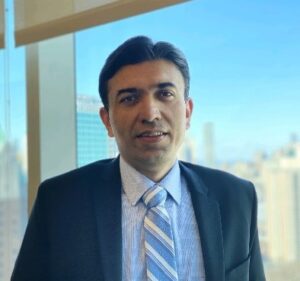
‘Technology is not something we can hide from students’: How NYC Public Schools invited AI into its classrooms
Generative AI burst onto the scene in late 2022 with the launch of ChatGPT. Almost overnight, the technology – capable of creating new content in real-time – was everywhere.
But New York City Public Schools soon declared one place generative AI would not be: its classrooms.
“When ChatGPT launched, it literally shook up the entire IT universe,” said Zeeshan Anwar, the district’s chief product officer. “And our first reaction was to block it in schools because we didn’t know how teachers and students would react and use the technology.”
Caution morphed into curiosity, however. Principals started to request access to ChatGPT for their schools. By May 2023, the head of New York City Public Schools wrote an Op-ed announcing the district was reversing course.

“Eventually we just realized that technology is not something we can hide from students,” Anwar said. “You need to embrace it, introduce it in a controlled fashion. So we said, ‘OK, we have a data foundation. ChatGPT and OpenAI are here. Let’s work with Microsoft to bring this into the classroom.’”
The result of that collaboration: a custom AI-powered teaching assistant that can offer real-time feedback and answer questions for students. It was built on Azure OpenAI Service, which provides organizations access to OpenAI’s models (including ChatGPT) combined with Azure’s enterprise capabilities and the AI-optimized infrastructure of Azure.
The school district recently piloted the assistant in three high school computer science courses. In a two-week span, nearly 100 students asked the teaching assistant more than 2,000 questions – exponentially more than the three teachers could have fielded, said Tara Carrozza, director of the district’s Digital Learning and Innovation (DLI) team.
Microsoft Source spoke with Anwar and Carrozza about the teaching assistant, what they’ve learned from the pilot and the promise of AI in the classroom.
SOURCE: What was the district’s goal in creating an AI-powered chatbot?
CARROZZA: We’re focused on creating 21st century, student-centered classrooms. That’s really where the concept of the teaching assistant comes from: We want to give as much individualized support as possible to every student. It allows for continuous and personalized feedback to a student.

SOURCE: How did you go about bringing that concept to life?
CARROZZA: When the Op-ed came out, interest in generative AI and AI-empowered tools went through the roof. We have a team of Digital Learning and Innovation teacher ambassadors who created resources and lessons on how to critically consider AI in the classroom across different content areas, different grades, and specifically for students with disabilities and multilingual learners. We also created, in partnership with our Computer Science for All team, a citywide foundational course called “From AI to Generative AI in Education.”
Our quick agility to build and pilot the teaching assistant, and do a very rapid continuous feedback loop with both high school students and staff, was in part from using the open-resource Microsoft TEALS intro to computer science curriculum.
SOURCE: So you had the curriculum. But where did the data come from?
ANWAR: During Covid, we worked with Microsoft to create a data hub we call DAP – data as a platform. Currently, DAP has close to 2 billion records. That data was our foundation when we began collaborating with Microsoft on the teaching assistant.
It is critical for everyone to understand that the model and the data only live in the (Department of Education) environment. Building this on Azure OpenAI Service is key for us in terms of security of our data.
CARROZZA: The best thing about the partnership with Microsoft is that security is baked into everything. People ask, ‘How do we know it’s compliant? What’s happening with our data?’ But we’re working with the premier technology company in the world, so we know we’re doing it the right way.
SOURCE: What feedback did you get from teachers and students?
ANWAR: One of the first things we heard was that the chatbot gave answers too quickly. If I’m a student asking a question, the teacher might not give me a direct answer because they want me to think on my own, right? So teachers wanted the chatbot to take a step back and offer hints, to push the students and keep them thinking. The content filtration capabilities in Azure OpenAI Service make that very easy.
CARROZZA: We worked closely with the IT team on a pedagogical taxonomy of categorizing prompt types and outputs to support students discovering answers themselves. The scaffolded feedback helped keep students engaged and motivated by success to move along. Students are building their metacognition about how they personally are learning.
SOURCE: Is the dream true personalized learning, where the chatbot would tailor every response to the individual?
ANWAR: We’re not there yet but that is the longer goal we’re working on.
When a user logs into the AI hub, we have access to pertinent information regarding the student, including the school they are enrolled in, their current courses, attendance records and grades. We can also track the number of assignments submitted on time and identify areas where they may require assistance. All this data is securely stored within our data platform, which boasts robust layers of security and controlled access overseen by a select group of data administrators.
Based on that entire picture, the AI should be able to deliver a very specific, personalized set of answers. The dream is to interact with each student based on all that data so I can feed them information in a way they understand.
SOURCE: How does AI fit into the district’s educational goals?
CARROZZA: At the heart of our AI work, and why we’re embracing it in New York City, is equity. We must embrace emergent technologies that are pervasive across the world, to increase the equity of access and opportunity for our students, particularly for our Black and Brown students and our students with disabilities and multilingual learners.
Our mission is for students to graduate on a pathway to a rewarding career and long-term economic security, equipped to be a positive force for change. Our kids need to be exposed to these tools, to be fluent in them. If we are not using AI in education, we’re putting our students at risk of being behind.
SOURCE: What comes next?
ANWAR: We’ll collaborate with as many educators as we can. I want to hear from them how they want this technology to work in their classroom. Every classroom is unique, so I want to understand the specific needs of their classrooms.
And we’ll talk to students as well about how they would like to use the technology. We’ll take that feedback and grow the AI hub and the teaching assistant. My goal is that this technology should be enabled in each and every school and in each and every classroom.
Top photo by SDI Productions/Getty Images. Portraits courtesy of NYC Public Schools.
